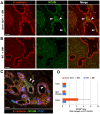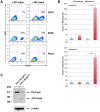Macrophage/epithelium cross-talk regulates cell cycle progression and migration in pancreatic progenitors
- PMID: 24586821
- PMCID: PMC3929706
- DOI: 10.1371/journal.pone.0089492
Macrophage/epithelium cross-talk regulates cell cycle progression and migration in pancreatic progenitors
Abstract
Macrophages populate the mesenchymal compartment of all organs during embryogenesis and have been shown to support tissue organogenesis and regeneration by regulating remodeling of the extracellular microenvironment. Whether this mesenchymal component can also dictate select developmental decisions in epithelia is unknown. Here, using the embryonic pancreatic epithelium as model system, we show that macrophages drive the epithelium to execute two developmentally important choices, i.e. the exit from cell cycle and the acquisition of a migratory phenotype. We demonstrate that these developmental decisions are effectively imparted by macrophages activated toward an M2 fetal-like functional state, and involve modulation of the adhesion receptor NCAM and an uncommon "paired-less" isoform of the transcription factor PAX6 in the epithelium. Over-expression of this PAX6 variant in pancreatic epithelia controls both cell motility and cell cycle progression in a gene-dosage dependent fashion. Importantly, induction of these phenotypes in embryonic pancreatic transplants by M2 macrophages in vivo is associated with an increased frequency of endocrine-committed cells emerging from ductal progenitor pools. These results identify M2 macrophages as key effectors capable of coordinating epithelial cell cycle withdrawal and cell migration, two events critical to pancreatic progenitors' delamination and progression toward their differentiated fates.
Conflict of interest statement
Figures









Similar articles
-
Mechanosignalling via integrins directs fate decisions of pancreatic progenitors.Nature. 2018 Dec;564(7734):114-118. doi: 10.1038/s41586-018-0762-2. Epub 2018 Nov 28. Nature. 2018. PMID: 30487608
-
GDNF is required for neural colonization of the pancreas.Development. 2013 Sep;140(17):3669-79. doi: 10.1242/dev.091256. Epub 2013 Jul 31. Development. 2013. PMID: 23903190
-
Pancreatic mesenchyme regulates epithelial organogenesis throughout development.PLoS Biol. 2011 Sep;9(9):e1001143. doi: 10.1371/journal.pbio.1001143. Epub 2011 Sep 6. PLoS Biol. 2011. PMID: 21909240 Free PMC article.
-
Pancreas organogenesis: The interplay between surrounding microenvironment(s) and epithelium-intrinsic factors.Curr Top Dev Biol. 2019;132:221-256. doi: 10.1016/bs.ctdb.2018.12.005. Epub 2019 Jan 2. Curr Top Dev Biol. 2019. PMID: 30797510 Review.
-
[Pancreatic development and stem cell-based regenerative medicine].Rinsho Byori. 2006 Apr;54(4):386-92. Rinsho Byori. 2006. PMID: 16722458 Review. Japanese.
Cited by
-
Coordinated interactions between endothelial cells and macrophages in the islet microenvironment promote β cell regeneration.NPJ Regen Med. 2021 Apr 6;6(1):22. doi: 10.1038/s41536-021-00129-z. NPJ Regen Med. 2021. PMID: 33824346 Free PMC article.
-
Multifaceted cancer alleviation by cowpea mosaic virus in a bioprinted ovarian cancer peritoneal spheroid model.Biomaterials. 2024 Dec;311:122663. doi: 10.1016/j.biomaterials.2024.122663. Epub 2024 Jun 10. Biomaterials. 2024. PMID: 38878481 Free PMC article.
-
Minireview: Emerging Concepts in Islet Macrophage Biology in Type 2 Diabetes.Mol Endocrinol. 2015 Jul;29(7):946-62. doi: 10.1210/me.2014-1393. Epub 2015 May 22. Mol Endocrinol. 2015. PMID: 26001058 Free PMC article. Review.
-
Crosstalk between Macrophages and Pancreatic β-Cells in Islet Development, Homeostasis and Disease.Int J Mol Sci. 2021 Feb 10;22(4):1765. doi: 10.3390/ijms22041765. Int J Mol Sci. 2021. PMID: 33578952 Free PMC article. Review.
-
Signals in the pancreatic islet microenvironment influence β-cell proliferation.Diabetes Obes Metab. 2017 Sep;19 Suppl 1(Suppl 1):124-136. doi: 10.1111/dom.13031. Diabetes Obes Metab. 2017. PMID: 28880471 Free PMC article. Review.
References
-
- Stappenbeck TS, Miyoshi H (2009) The role of stromal stem cells in tissue regeneration and wound repair. Science 324: 1666–1669. - PubMed
-
- Morris L, Graham CF, Gordon S (1991) Macrophages in haemopoietic and other tissues of the developing mouse detected by the monoclonal antibody F4/80. Development 112: 517–526. - PubMed
-
- Dai XM, Ryan GR, Hapel AJ, Dominguez MG, Russell RG, et al. (2002) Targeted disruption of the mouse colony-stimulating factor 1 receptor gene results in osteopetrosis, mononuclear phagocyte deficiency, increased primitive progenitor cell frequencies, and reproductive defects. Blood 99: 111–120. - PubMed
-
- Michaelson MD, Bieri PL, Mehler MF, Xu H, Arezzo JC, et al. (1996) CSF-1 deficiency in mice results in abnormal brain development. Development 122: 2661–2672. - PubMed
Publication types
MeSH terms
Substances
Grants and funding
LinkOut - more resources
Full Text Sources
Other Literature Sources
Medical
Research Materials
Miscellaneous

